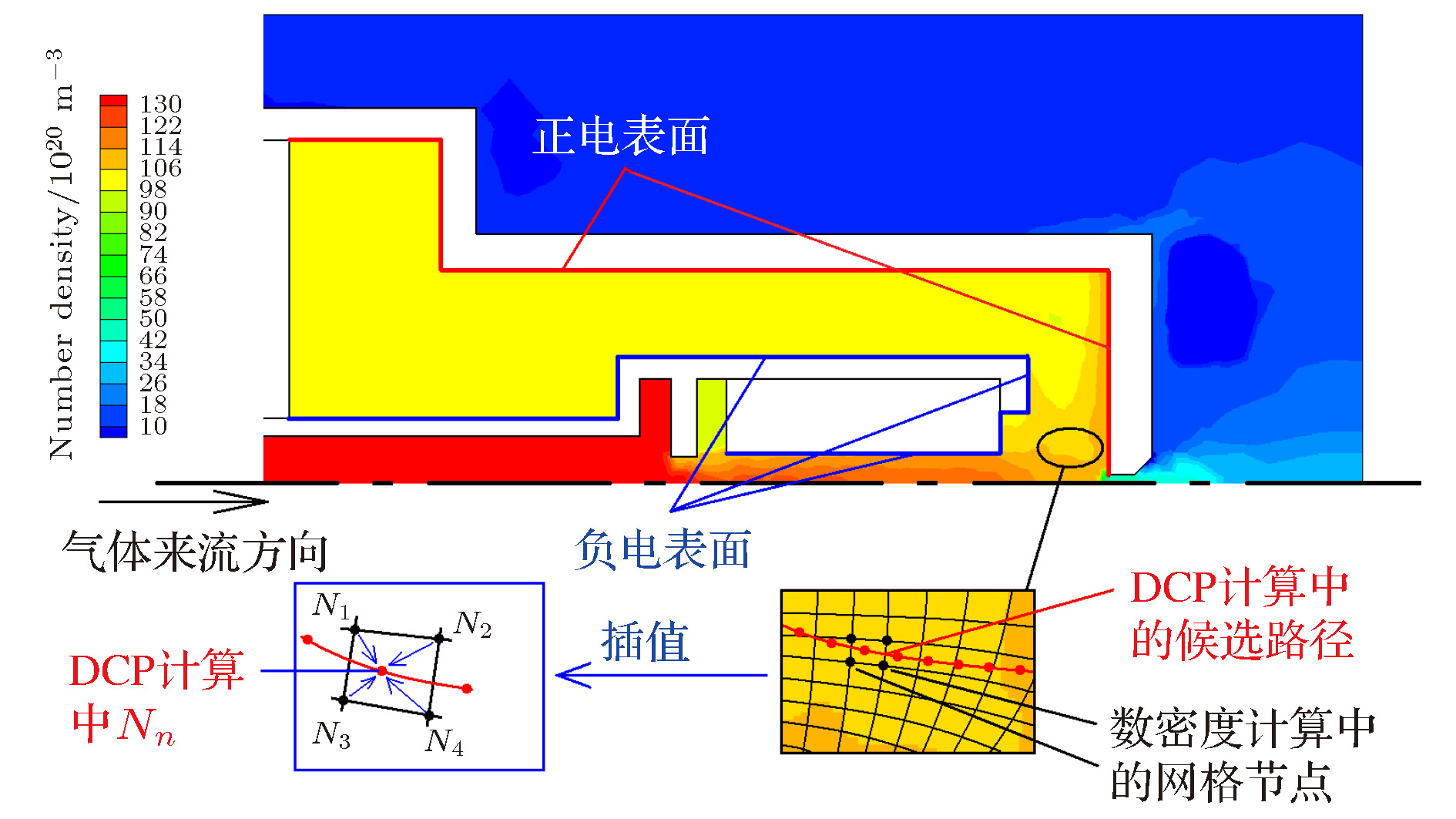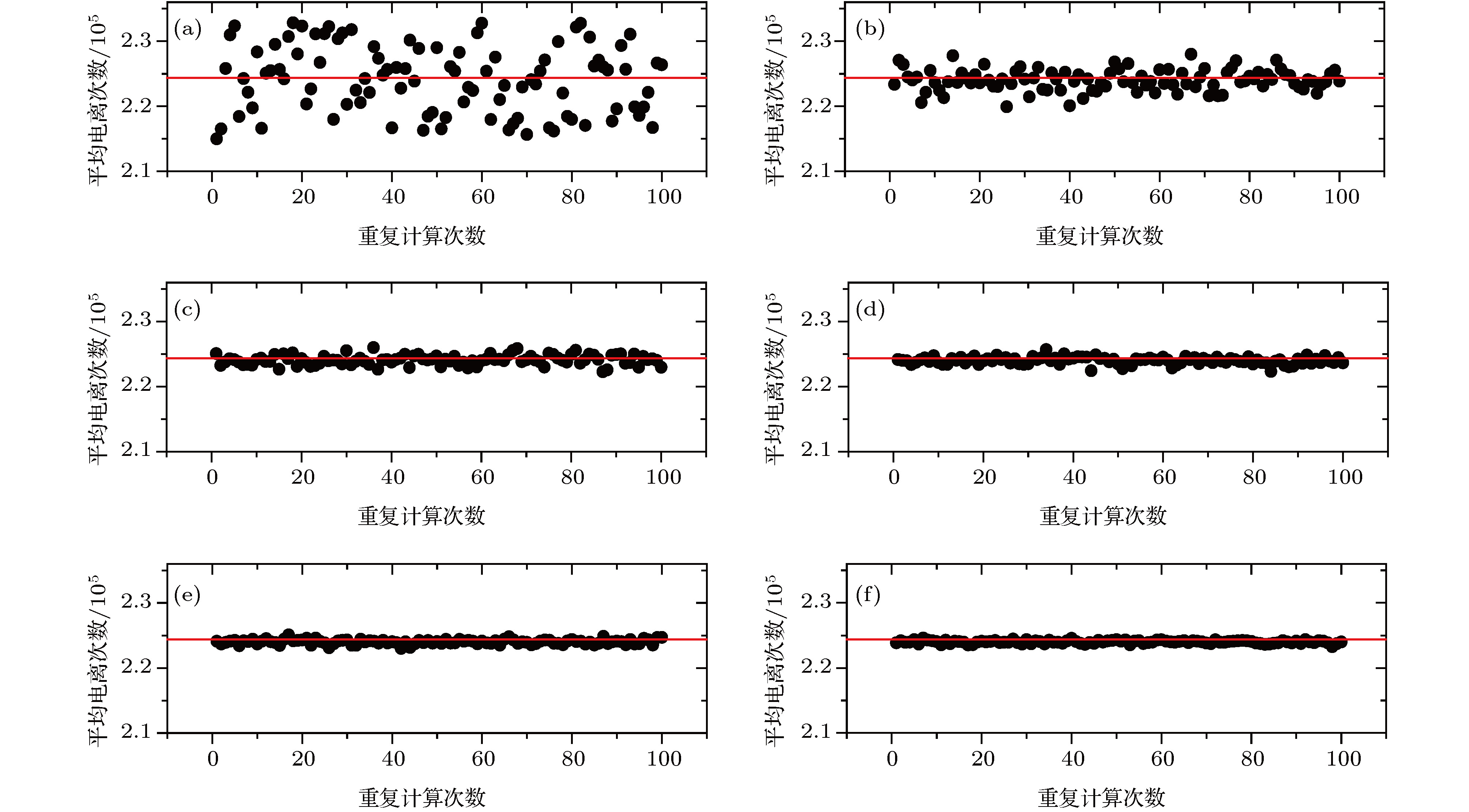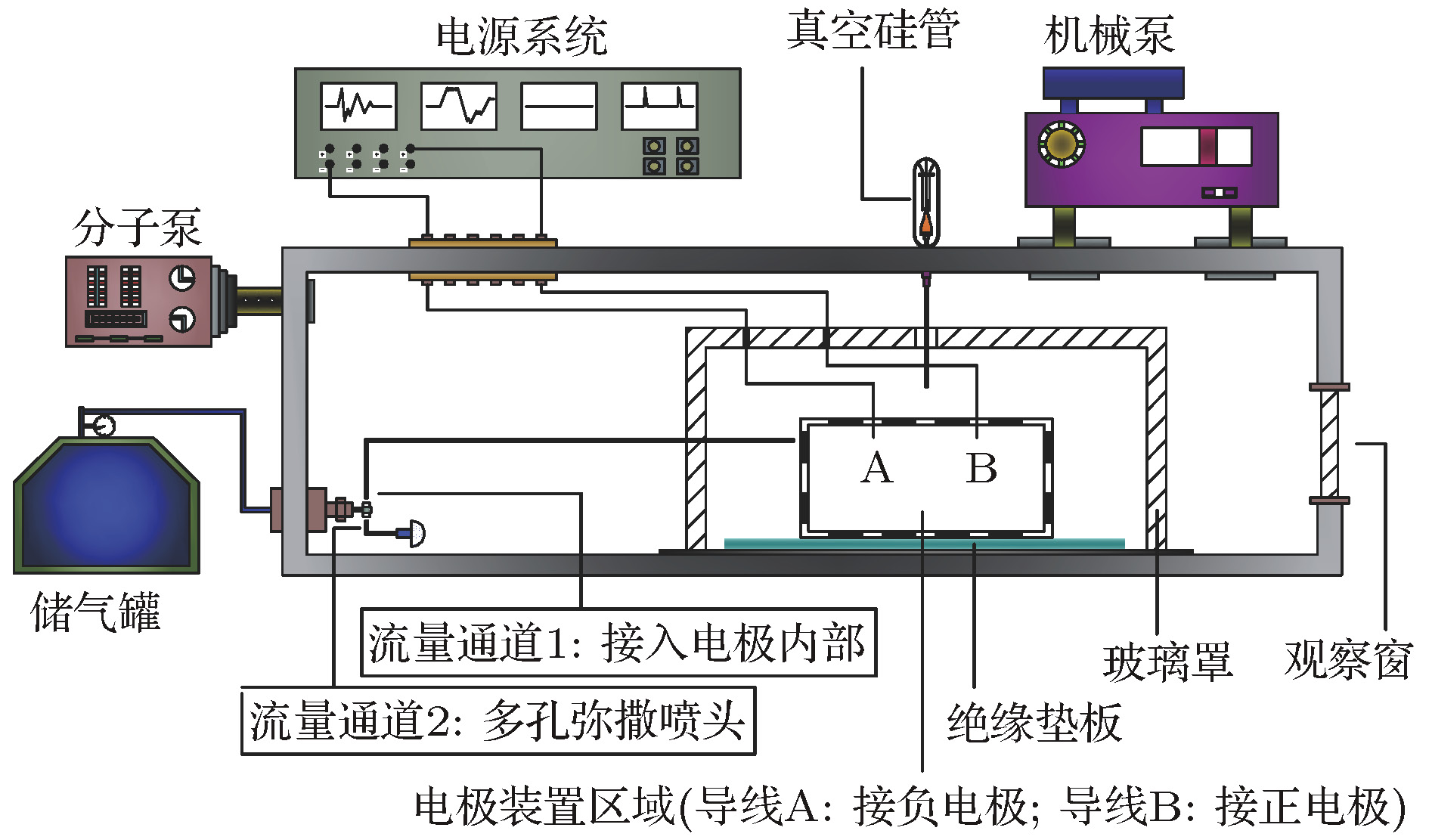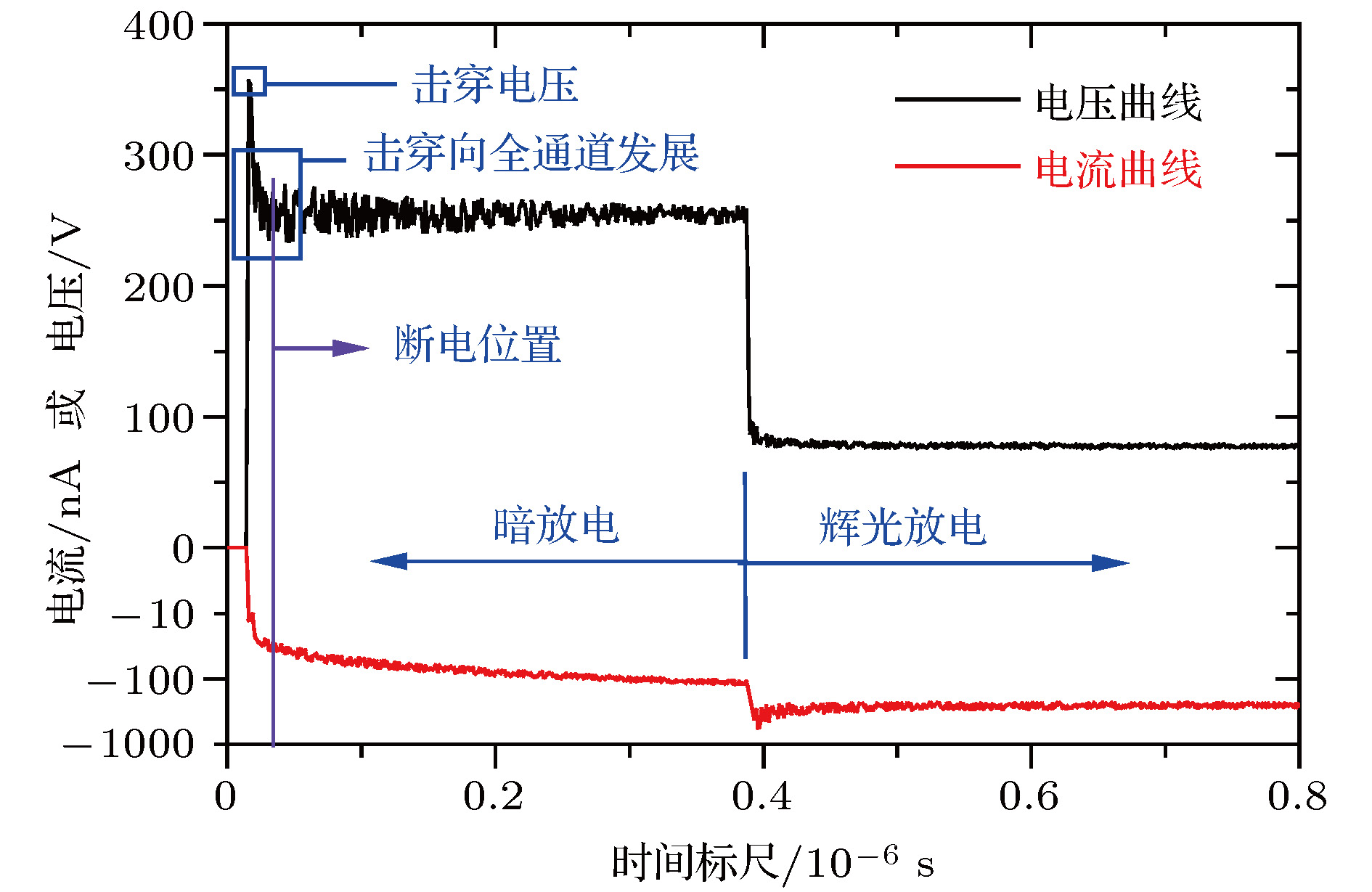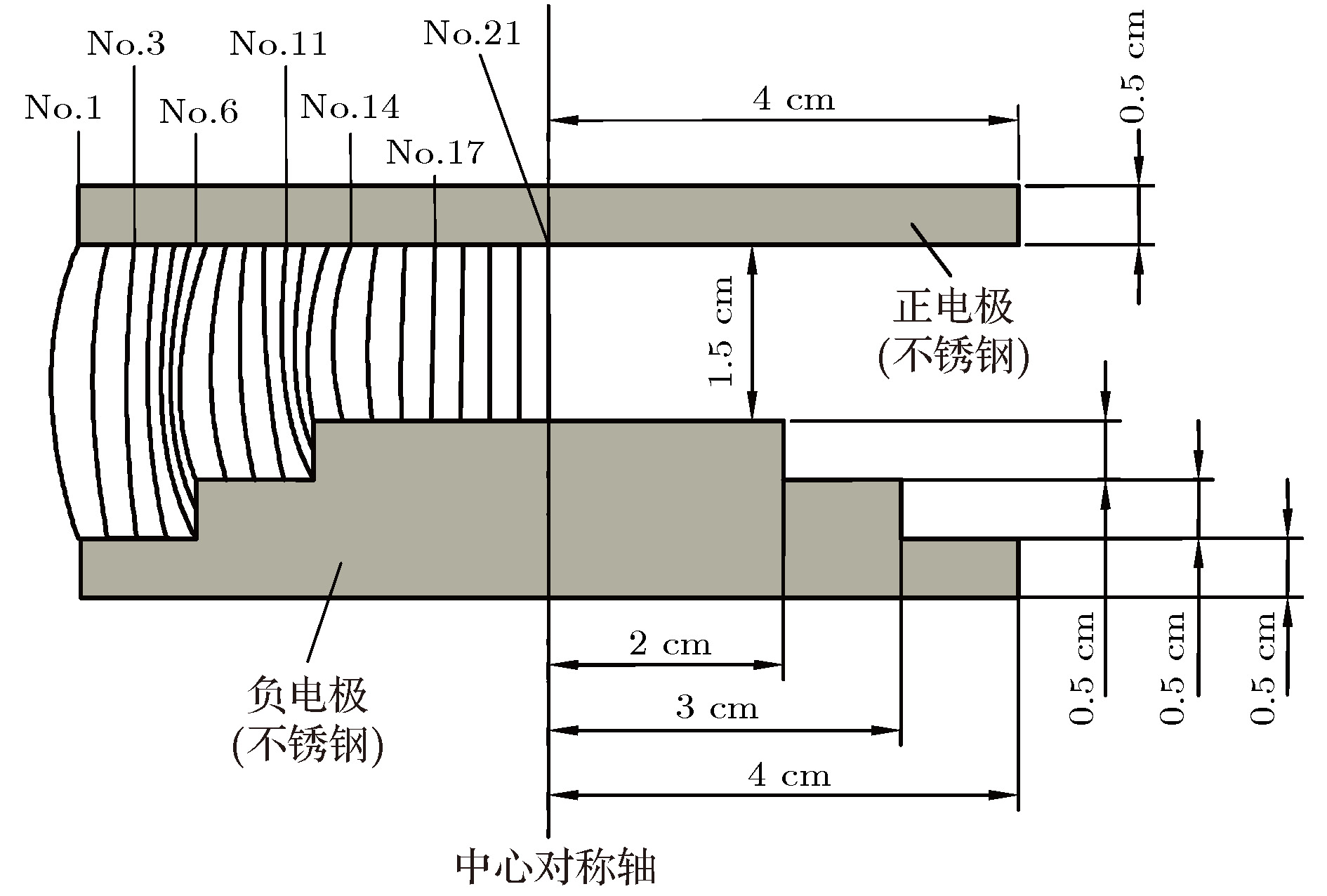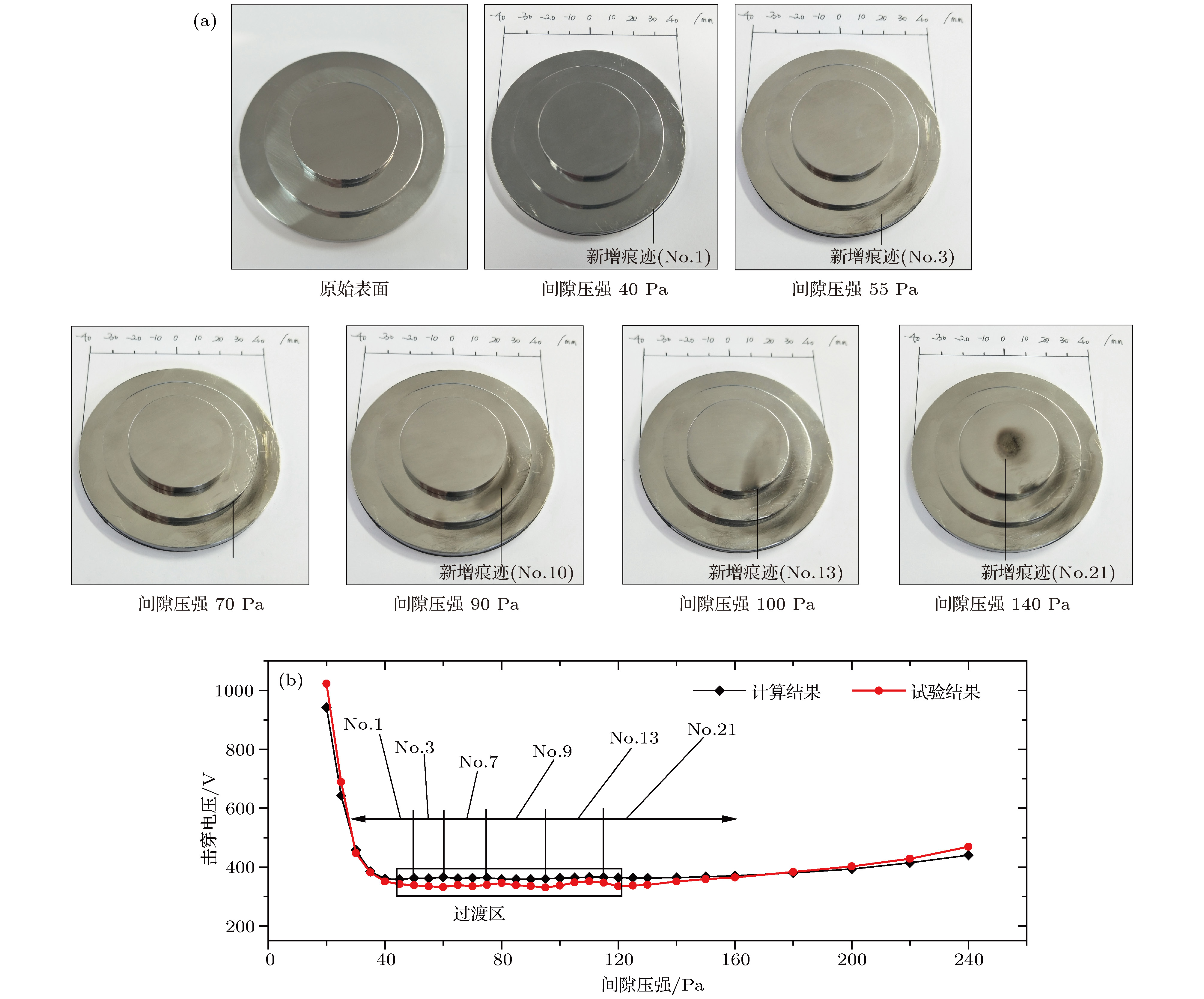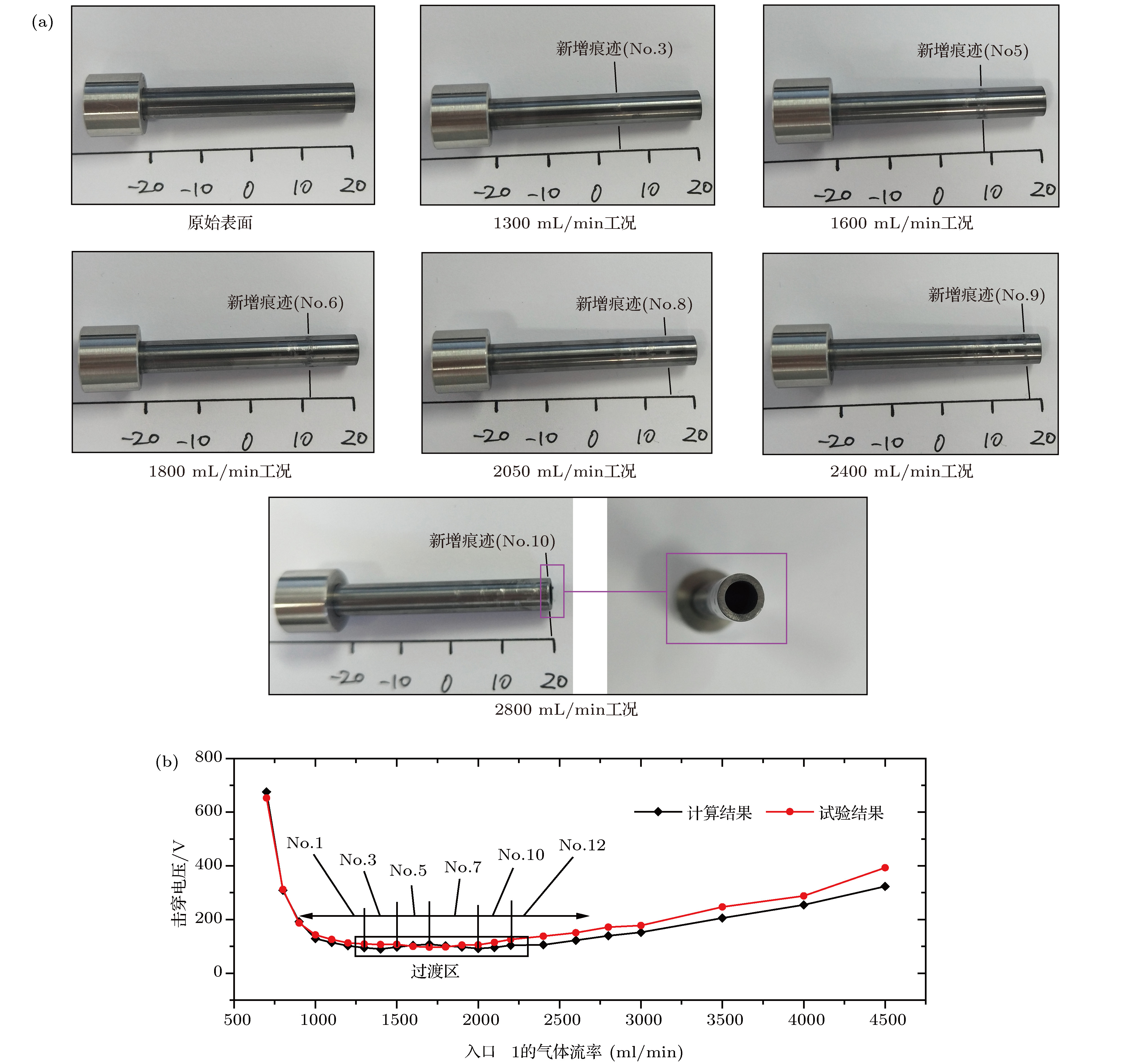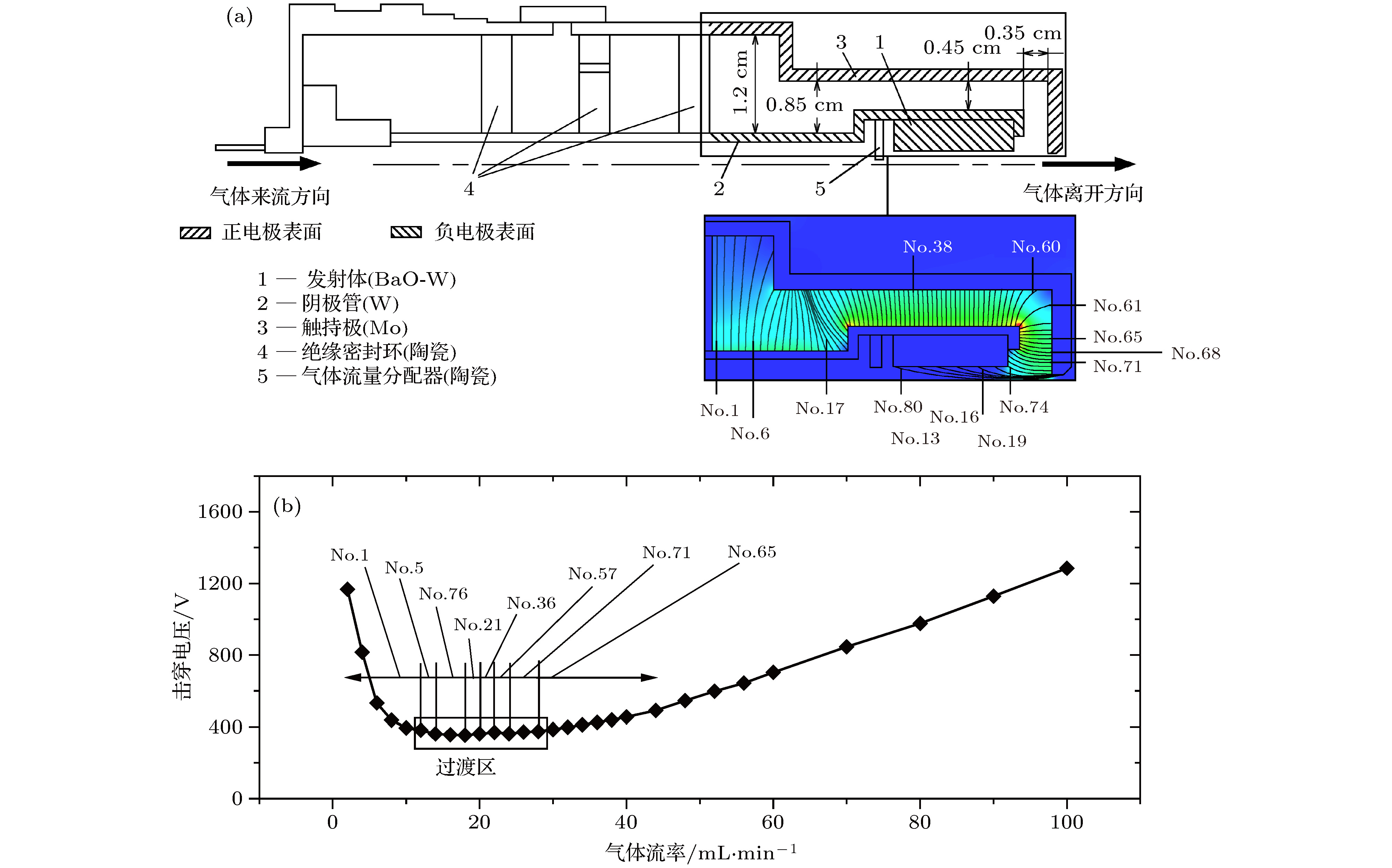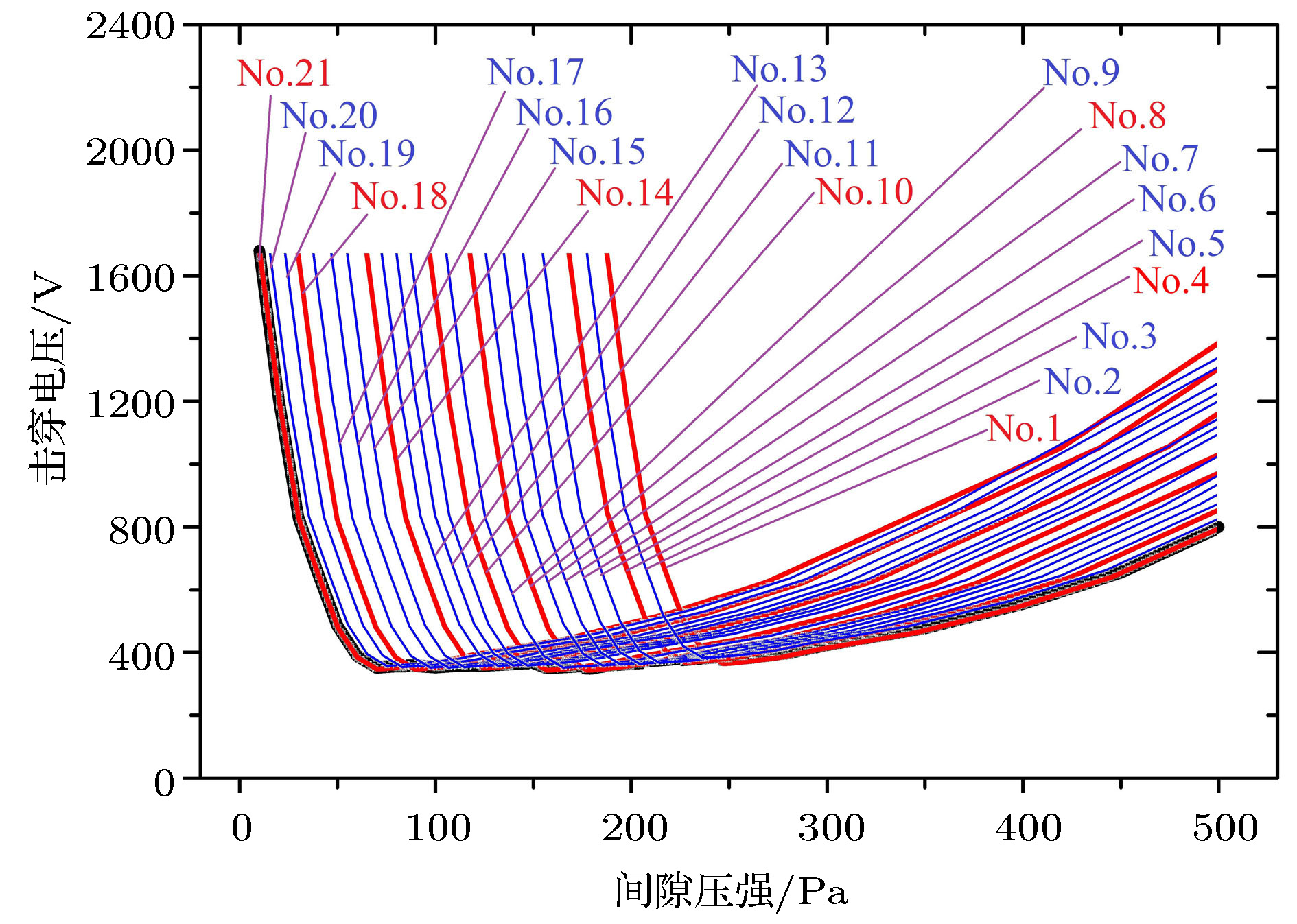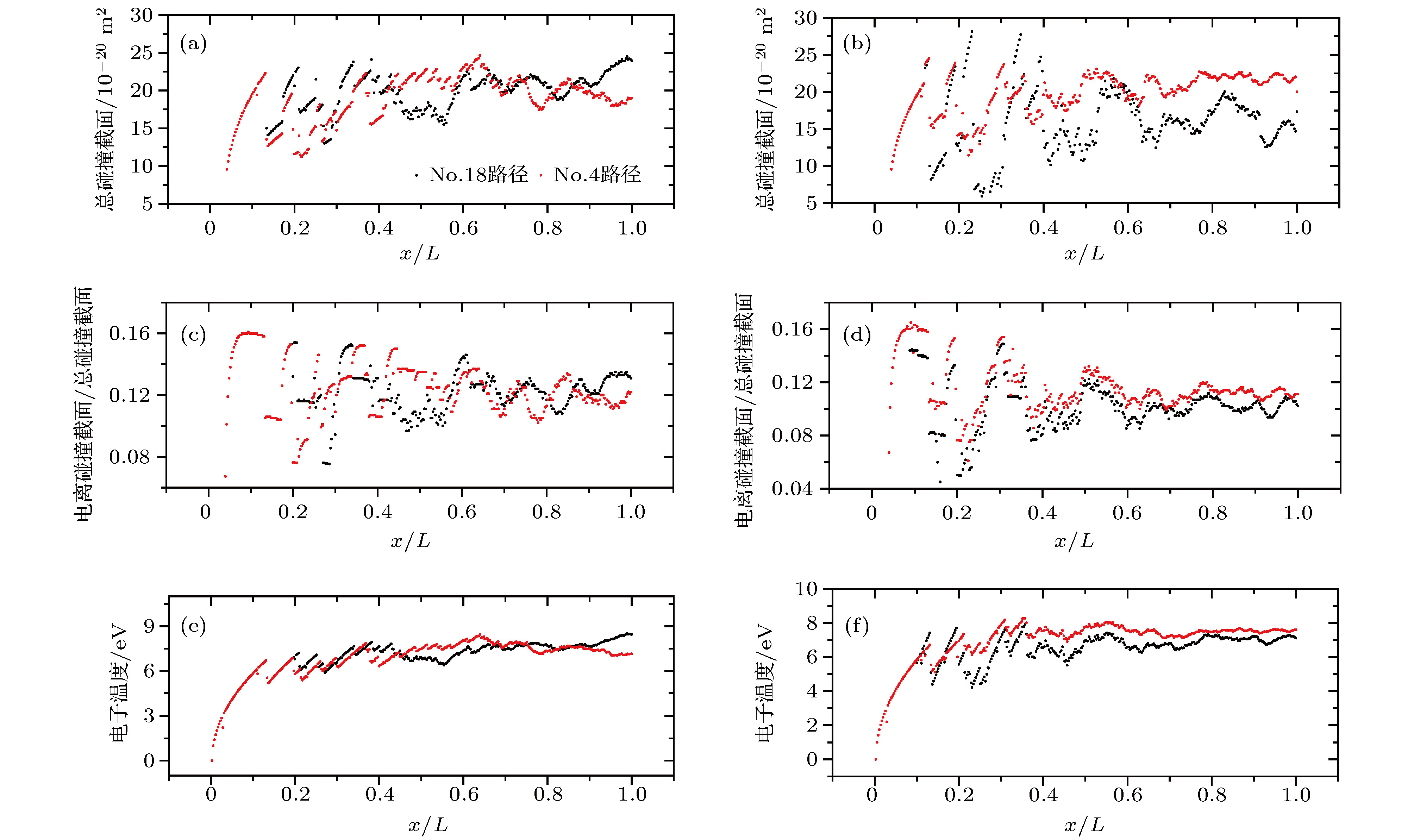-
The determination of the critical breakdown path in slightly uneven electric field has played a significant role in gas discharge starting process and electrode surface erosion. In order to study the law of the critical path position in the low-pressure breakdown case, a new algorithm based on the Monte-Carlo collision model and the postulation of " forward-back trajectory for electrons” is established, namely the determination of the critical path(DCP) model. In the DCP model, some electric field lines among the electrodes are regarded as the potential breakdown paths, and the probability of the excitation and ionization collisions between the electrons and the neutrals can be obtained by the Monte-Carlo model. The most probable path to trigger the breakdown will be selected from among all the potential paths, namely the critical breakdown path, and the corresponding breakdown voltage of the critical path will be calculated. A breakdown test with two different electrode devices is performed to examine the accuracy of the DCP model: the critical path and breakdown voltage obtained by the DCP could be examined respectively by capturing the surface traces of negative electrode and measuring the breakdown voltage. According to the test results, the critical breakdown path can transit at different gap pressures or flow rates, and this observation is qualitatively consistent with the calculation results. Meanwhile, the relative error maximum of the breakdown voltage obtained by DCP is less than 7.9%. The accuracy of the DCP model partly depends on the background pressure, and the background pressure in the application case should be less than 103 Pa. Based on the DCP model, the numerical analyses of another four electrode devices are conducted to acquire the common law about the critical breakdown path. According to the calculation results, the transition zone has both a high frequency of critical path transition and a " fluctuant and similarly straight” breakdown voltage curve with the gap pressure or flow rate increasing, and the critical path transition direction follows the rule of " from longer paths to shorter paths”. Lastly, the inherent laws of those regulations about the critical path are revealed by the DCP model.
-
Keywords:
- gap of slightly uneven electric field /
- critical breakdown path /
- path transition /
- numerical simulation
[1] Paschen F 1889 Wied. Annal. Phys. Chem. 37 69
[2] Golden D E, Fisher L H 1965 Phys. Rev. 139 1452
 Google Scholar
Google Scholar
[3] Kagan Y M 1991 J. Phys. D: Appl. Phys. 24 882
 Google Scholar
Google Scholar
[4] Osmokrovic P, Loncar B, Gajic-Kvascev M 2004 IEEE Trans. Plasma Sci. 32 1849
 Google Scholar
Google Scholar
[5] Osmokrovic P, Vasic A 2005 IEEE Trans. Plasma Sci. 33 1672
 Google Scholar
Google Scholar
[6] Niemeyer L, Pietronero L, Wiesmann H J 1984 Phys. Rev. Lett. 52 1033
 Google Scholar
Google Scholar
[7] Wiesmann H J, Zeller H R 1986 J. Phys. D: Appl. Phys. 60 1770
 Google Scholar
Google Scholar
[8] Niemeyer L 1987 J. Phys. D: Appl. Phys. 20 897
 Google Scholar
Google Scholar
[9] Noskov M D, Kukhta V R, Lopatin V V 1995 J. Phys. D: Appl. Phys. 28 1187
 Google Scholar
Google Scholar
[10] Dulan A, Upul S A, Marcus B B, Vernon C 2015 J. Electrostat. 73 33
 Google Scholar
Google Scholar
[11] 火元莲, 张广庶, 吕世华, 袁萍 2013 物理学报 62 059201
 Google Scholar
Google Scholar
Huo Y L, Zhang G S, Lü S H, Yuan P 2013 Acta Phy. Sin. 62 059201
 Google Scholar
Google Scholar
[12] 郑殿春, 丁宁, 沈湘东, 赵大伟, 郑秋平, 魏红庆 2016 物理学报 65 024703
 Google Scholar
Google Scholar
Zheng D C, Ding N, Shen X D, Zhao D W, Zheng Q P, Wei H Q 2016 Acta Phy. Sin. 65 024703
 Google Scholar
Google Scholar
[13] Townsend J S 1925 J. Franklin Inst. 200 563
 Google Scholar
Google Scholar
[14] Mahalingam S, Nieter C, Loverich J, Smithe D, Stoltz P 2009 Open Plasma Phys. J. 2 63
 Google Scholar
Google Scholar
[15] Venkattraman A, Alexeenko A A 2012 P. Plasmas 19 123515
 Google Scholar
Google Scholar
[16] Shklyaev V A, Belomyttsev S Y, Ryzhov V V 2012 J. Appl. Phys. 112 113303
 Google Scholar
Google Scholar
[17] Macheret S O, Shneider M N 2013 Phys. Plasmas 20 101608
 Google Scholar
Google Scholar
[18] Szabo J J, Warner N, Martinez-Sanchez M 2014 J. Propul. Power 30 197
 Google Scholar
Google Scholar
[19] 谢爱根, 张健, 刘斌, 王铁邦 2012 强激光与粒子束 24 481
Xie A G, Zhang J, Liu B, Wang T B 2012 High Power Laser and Particle Beams 24 481
[20] Huerta M, Ludeking L 2010 48th AIAA Aerospace Sciences Meeting Including the New Horizons Forum and Aerospace Exposition Orlando, USA, January 4-7, 2010 p1
[21] 武占成, 张希军, 胡有志 2012 气体放电 (北京: 国防工业出版社) 第69页
Wu Z C, Zhang X J, Hu Y Z 2012 Gas Discharge (Beijing: National Defense Industry Press) p69 (in Chinese)
[22] Daykin-Iliopoulos A, Gabriel S, Golosnoy I, Kubota K, Funaki I 2015 34th International Electric Propulsion Conference Hyogo-Kobe, Japan, July 4-10, 2015 p1
[23] Zhao Y , Qing A , Meng Y , Song Z, Lin C 2018 Scientific Reports 8 1729
[24] Zhao Y, Huang C, Qing A, Luo X 2017 IEEE Photonics Journal 9 1
-
图 3 DCP计算结果稳定性随N0的依变关系(a) n0 = 1; (b) n0 = 10; (c) n0 = 50; (d) n0 = 100; (e) n0 = 200; (f) n0 = 500 (case 1, 间隙压强60 Pa, 临界击穿电压345 V)
Figure 3. The computational stability of DCP model as a function of N0: (a) n0 = 1; (b) n0 = 10; (c) n0 = 50; (d) n0 = 100; (e) n0 = 200; (f) n0 = 500 (An example of case 1, gap pressure: 60 Pa, critical breakdown voltage: 345 V )
图 11 Case 3的计算输入条件及计算结果(气体工质: Xe) (a)电极结构及候选路径划分(f = 2.45); (b)V-p曲线的计算结果及起始路径分布
Figure 11. The input conditions and calculation results in case 3 (working medium: Xe): (a) The electrode geometry and potential path generation; (b) the calculation results of the V-p curve and the critical path distribution
图 12 Case 4的计算输入条件及计算结果(气体工质: Xe) (a)电极结构及候选路径划分(f = 3.76); (b)V-fr曲线的计算结果及起始路径分布
Figure 12. The input conditions and calculation results in case 4(working medium: Xe): (a) The electrode geometry and potential path generation; (b) the calculation results of the V-p curve and the critical path distribution
图 13 Case 5的计算输入条件及计算结果(气体工质: Ar): (a) 电极结构及候选路径划分(f = 3.43); (b) V-p曲线的计算结果及起始路径分布
Figure 13. The input conditions and calculation results in case 5 (working medium: Ar): (a) The electrode geometry and potential path generation; (b) the calculation results of the V-p curve and the critical path distribution
图 14 Case 6的计算输入条件及计算结果(气体工质: Xe) (a)电极结构及候选路径划分(f = 2.84); (b)V-p曲线的计算结果及起始路径分布
Figure 14. The input conditions and calculation results in case 6(working medium: Xe): (a) The electrode geometry and potential path generation; (b) the calculation results of the V-p curve and the critical path distribution
图 17
${\sigma _T}\left({E_{{k},e}}\right)$ ,${\sigma _{{\rm{ion}}}}\left({E_{{k},e}}\right)/{\sigma _T}\left({E_{{k},e}}\right)$ 和${E_{{k},e}}$ 在不同压强、不同候选路径上的分布规律(case 3) (a)平均${\sigma _T}\left({E_{{k},e}}\right)$ , p = 40 Pa; (b)平均${\sigma _T}\left({E_{{k},e}}\right)$ , p = 80 Pa; (c)平均${\sigma _{{\rm{ion}}}}\left({E_{{k},e}}\right)/{\sigma _T}\left({E_{{k},e}}\right)$ , p = 40 Pa; (d)平均${\sigma _{{\rm{ion}}}}\left({E_{{k},e}}\right)/{\sigma _T}\left({E_{{k},e}}\right)$ , p = 80 Pa; (e)平均${E_{{k},e}}$ , p = 40 Pa; (f)各节点的平均${E_{{k},e}}$ , p = 80 PaFigure 17. The distribution of
${\sigma _T}\left({E_{{k},e}}\right)$ ,${\sigma _{{\rm{ion}}}}\left({E_{{k},e}}\right)/{\sigma _T}\left({E_{{k},e}}\right)$ and${E_{{k},e}}$ at different gap pressures and different potential paths in case 3: (a) The average${\sigma _T}\left({E_{{k},e}}\right)$ , p = 40 Pa; (b) the average${\sigma _T}\left({E_{{k},e}}\right)$ , p = 80 Pa; (c) the average${\sigma _{{\rm{ion}}}}\left({E_{{k},e}}\right)/{\sigma _T}\left({E_{{k},e}}\right)$ , p = 40 Pa; (d) the average${\sigma _{{\rm{ion}}}}\left({E_{{k},e}}\right)/{\sigma _T}\left({E_{{k},e}}\right)$ , p = 80 Pa; (e) the average${E_{{k},e}}$ , p = 40 Pa; (f) the average${E_{{k},e}}$ , p = 80 Pa碰撞类型 碰撞截面公式/m2 弹性碰撞 $1.699 \times {10^{ - 19}}$ ${E_{k,e}} \leqslant 0.159\; {\rm{ eV}}$ $(0.076E_{k,e}^2 - 0.345E_{k,e}^{1.5} + 0.585{E_{k,e}} - 0.427E_{k,e}^{0.5} + 0.114)\times {10^{ - 17}}$ $0.16\; {\rm{ eV}} < {E_{k,e}} \leqslant 2.8\; {\rm{ eV}}$ $( - 0.002E_{k,e}^2 + 0.03E_{k,e}^{1.5} - 0.166{E_{k,e}} + 0.402E_{k,e}^{0.5} - 0.317)\times {10^{ - 17}}$ $2.8\; {\rm{ eV}} < {E_{k,e}} \leqslant 24.7\; {\rm{ eV}}$ $( - 0.0022E_{k,e}^{1.5} + 0.043{E_{k,e}} - 0.28567E_{k,e}^{0.5} + 0.6518)\times {10^{ - 17}}$ $24.7\; {\rm{ eV}} < {E_{k,e}} \leqslant 50\; {\rm{ eV}}$ $0.00064 \times {10^{ - 17}}$ ${E_{k,e}} > 50\; {\rm{ eV}}$ 激发碰撞 $0.0$ ${E_{k,e}} \leqslant 8.4\; {\rm{ eV}}$ $(0.002E_{k,e}^2 - 0.023E_{k,e}^{1.5} + 0.098{E_{k,e}} - 0.188E_{k,e}^{0.5} + 0.135)\times {10^{ - 16}}$ $8.4\; {\rm{ eV}} < {E_{k,e}} \leqslant 11\; {\rm{ eV}}$ $(0.0007E_{k,e}^2 - 0.012E_{k,e}^{1.5} + 0.08{E_{k,e}} - 0.23E_{k,e}^{0.5} + 0.23)\times {10^{ - 17}}$ $11\; {\rm{ eV}} < {E_{k,e}} \leqslant 25\; {\rm{ eV}}$ $\begin{gathered}(0.1 \times {10^{ - 6}}E_{k,e}^2 + 0.8 \times {10^{ - 5}}E_{k,e}^{1.5} - 0.0002{E_{k,e}} + 0.002E_{k,e}^{0.5} + 0.001)\hfill \\ \times {10^{ - 17}} \hfill \\ \end{gathered} $ $25\; {\rm{ eV}} < {E_{k,e}} \leqslant 500\; {\rm{ eV}}$ 电离碰撞 $0.0$ ${E_{k,e}} \leqslant 12.1\; {\rm{ eV}}$ $(0.00136E_{k,e}^2 - 0.0226E_{k,e}^{1.5} + 0.14{E_{k,e}} - 0.38E_{k,e}^{0.5} + 0.387)\times {10^{ - 17}}$ $12.1\; {\rm{ eV}} < {E_{k,e}} \leqslant 20\; {\rm{ eV}}$ $( - 0.0006E_{k,e}^2 + 0.014E_{k,e}^{1.5} - 0.133{E_{k,e}} + 0.574E_{k,e}^{0.5} - 0.93)\times {10^{ - 17}}$ $20\; {\rm{ eV}} < {E_{k,e}} \leqslant 44\; {\rm{ eV}}$ $( - 1.6 \times {10^{ - 6}}E_{k,e}^2 + 0.1E_{k,e}^{1.5} - 0.024{E_{k,e}} + 0.022E_{k,e}^{0.5} - 0.02)\times {10^{ - 17}}$ $44\; {\rm{ eV}} < {E_{k,e}} \leqslant 360\; {\rm{ eV}}$ -
[1] Paschen F 1889 Wied. Annal. Phys. Chem. 37 69
[2] Golden D E, Fisher L H 1965 Phys. Rev. 139 1452
 Google Scholar
Google Scholar
[3] Kagan Y M 1991 J. Phys. D: Appl. Phys. 24 882
 Google Scholar
Google Scholar
[4] Osmokrovic P, Loncar B, Gajic-Kvascev M 2004 IEEE Trans. Plasma Sci. 32 1849
 Google Scholar
Google Scholar
[5] Osmokrovic P, Vasic A 2005 IEEE Trans. Plasma Sci. 33 1672
 Google Scholar
Google Scholar
[6] Niemeyer L, Pietronero L, Wiesmann H J 1984 Phys. Rev. Lett. 52 1033
 Google Scholar
Google Scholar
[7] Wiesmann H J, Zeller H R 1986 J. Phys. D: Appl. Phys. 60 1770
 Google Scholar
Google Scholar
[8] Niemeyer L 1987 J. Phys. D: Appl. Phys. 20 897
 Google Scholar
Google Scholar
[9] Noskov M D, Kukhta V R, Lopatin V V 1995 J. Phys. D: Appl. Phys. 28 1187
 Google Scholar
Google Scholar
[10] Dulan A, Upul S A, Marcus B B, Vernon C 2015 J. Electrostat. 73 33
 Google Scholar
Google Scholar
[11] 火元莲, 张广庶, 吕世华, 袁萍 2013 物理学报 62 059201
 Google Scholar
Google Scholar
Huo Y L, Zhang G S, Lü S H, Yuan P 2013 Acta Phy. Sin. 62 059201
 Google Scholar
Google Scholar
[12] 郑殿春, 丁宁, 沈湘东, 赵大伟, 郑秋平, 魏红庆 2016 物理学报 65 024703
 Google Scholar
Google Scholar
Zheng D C, Ding N, Shen X D, Zhao D W, Zheng Q P, Wei H Q 2016 Acta Phy. Sin. 65 024703
 Google Scholar
Google Scholar
[13] Townsend J S 1925 J. Franklin Inst. 200 563
 Google Scholar
Google Scholar
[14] Mahalingam S, Nieter C, Loverich J, Smithe D, Stoltz P 2009 Open Plasma Phys. J. 2 63
 Google Scholar
Google Scholar
[15] Venkattraman A, Alexeenko A A 2012 P. Plasmas 19 123515
 Google Scholar
Google Scholar
[16] Shklyaev V A, Belomyttsev S Y, Ryzhov V V 2012 J. Appl. Phys. 112 113303
 Google Scholar
Google Scholar
[17] Macheret S O, Shneider M N 2013 Phys. Plasmas 20 101608
 Google Scholar
Google Scholar
[18] Szabo J J, Warner N, Martinez-Sanchez M 2014 J. Propul. Power 30 197
 Google Scholar
Google Scholar
[19] 谢爱根, 张健, 刘斌, 王铁邦 2012 强激光与粒子束 24 481
Xie A G, Zhang J, Liu B, Wang T B 2012 High Power Laser and Particle Beams 24 481
[20] Huerta M, Ludeking L 2010 48th AIAA Aerospace Sciences Meeting Including the New Horizons Forum and Aerospace Exposition Orlando, USA, January 4-7, 2010 p1
[21] 武占成, 张希军, 胡有志 2012 气体放电 (北京: 国防工业出版社) 第69页
Wu Z C, Zhang X J, Hu Y Z 2012 Gas Discharge (Beijing: National Defense Industry Press) p69 (in Chinese)
[22] Daykin-Iliopoulos A, Gabriel S, Golosnoy I, Kubota K, Funaki I 2015 34th International Electric Propulsion Conference Hyogo-Kobe, Japan, July 4-10, 2015 p1
[23] Zhao Y , Qing A , Meng Y , Song Z, Lin C 2018 Scientific Reports 8 1729
[24] Zhao Y, Huang C, Qing A, Luo X 2017 IEEE Photonics Journal 9 1
Catalog
Metrics
- Abstract views: 6818
- PDF Downloads: 63
- Cited By: 0














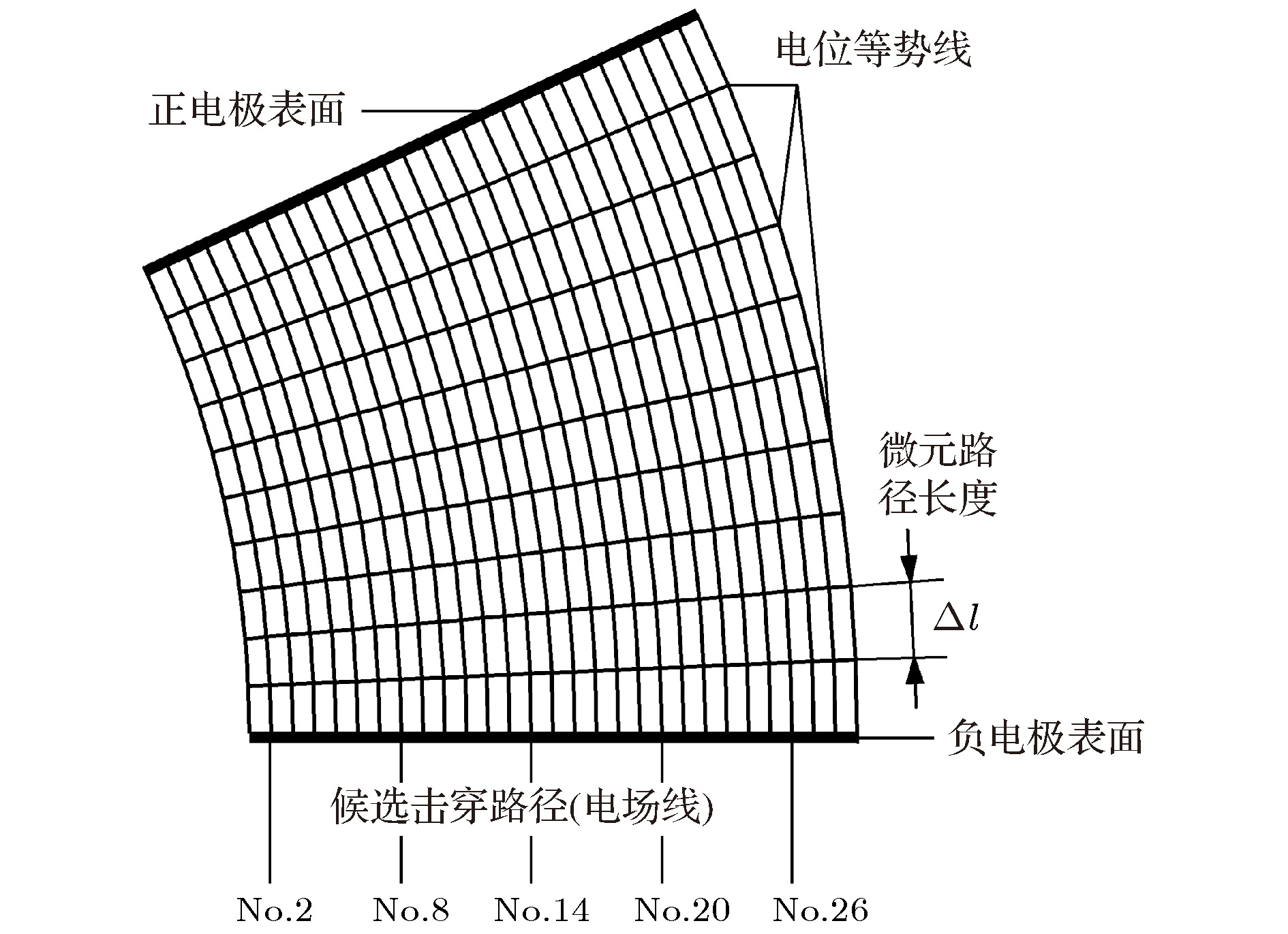
 DownLoad:
DownLoad:
